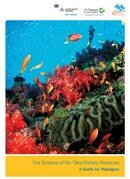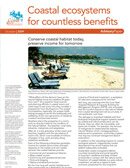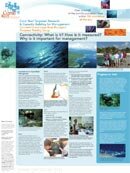The CRTR Program has a range of connectivity-related publications as well as Peer Reviewed Publications.
 |
The Science of No-Take Fishery Reserves: A Guide for Managers
This resource examines the science underlying the use of no-take fishery reserves as a management tool for coastal fisheries, with a focus on connectivity. It considers benefits of NTRs, optimal size, knowledge gaps and socio-economic factors.
>> English Document (revised 8/1/2010)
>> Spanish Document (revised 8/1/2010)
|
|
 |
Conserve coastal habitat today, preserve income for tomorrow
(October 2009)
CRTR Advisory paper on the economic, social and environmental importance
of conserving coastal habitats. Advice for planners and policy makers on
long-term approaches to coast development and actions that can be taken
today to preserve coastal habitats.
>> Download [PDF, 468kb]
|
|
 |
Poster: CRTR Program Connectivity Working Group
An introduction to Connectivity – what it is, how it is measured and why it is relevant to management.
>> Download
|
|
 |
In 2007 the Oceanography Society published a special issue of Oceanography focussing on marine population connectivity. Two papers, including a major review, were co-authored by members of the CRTR Program's Connectivity Working Group.
Read articles about population connectivity in marine systems.
|
|
 |
Critical science gaps impede use of no-take fishery reserves.
Peter F. Sale et al
As well as serving valuable biodiversity conservation roles, functioning no-take fishery reserves protect a portion of the fishery stock as insurance against future overfishing. So long as there is adequate compliance by the fishing community, it is likely that they will also sustain and even enhance fishery yields in the surrounding area.
>> Download
|
|
 |
Brochure: CRTR Program Summary
A comprehensive introduction to the CRTR Program’s objectives and goals against its research and capacity building agenda.
>> Download
|
|
 |
Research Update, July 2008
Read about the progress of the Connectivity Working Group.
>> Download
|